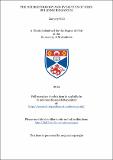Files in this item
The neuroethology and evolution of nest-building behaviour
Item metadata
| dc.contributor.advisor | Healy, Sue | |
| dc.contributor.author | Hall, Zachary J. | |
| dc.coverage.spatial | 176 | en_US |
| dc.date.accessioned | 2014-10-15T12:54:59Z | |
| dc.date.available | 2014-10-15T12:54:59Z | |
| dc.date.issued | 2014-12-01 | |
| dc.identifier.uri | https://hdl.handle.net/10023/5542 | |
| dc.description.abstract | A surge of recent work elucidating a role for learning and memory in avian nest-building behaviour has challenged the long-standing assumption that nest building develops under genetic control. Whereas that work has been addressed at describing the cognitive mechanisms underpinning nest-building behaviour, almost nothing is known about either the neurobiological processes controlling nest building or the selection pressures responsible for the diversity in avian nest-building behaviour. Here, I sought to identify both the neural substrates involved in nest-building behaviour and some of those selection pressures. First, I used expression of the immediate early gene product Fos, an indirect marker of neuronal activity, to identify brain regions activated during nest-building behaviour in the brains of nest-building and control zebra finches (Taeniogypia guttata). I found that neural circuits involved in motor control, social behaviour, and reward were activated during nest building. Furthermore, I found that subpopulations of neurons that signal using the nonapeptides vasotocin and mesotocin and the neurotransmitter dopamine located within some of these neural circuits were also activated during nest building, suggesting these cell-signalling molecules may be involved in controlling nest-building behaviour. Next, I found that variation in the amount of folding in the cerebellum, a brain structure thought to be involved in manipulative skills, increased with increasing nest structural complexity, suggesting that the cerebellum is also involved in nest building. Finally, using evolutionary statistical models, I found support for the hypothesis that nest-site competition off-ground and increased predation pressure on the ground in Old World babblers (Timaliidae) led to the co-evolution of building domed nests on the ground. Here, then, I provide the first evidence of potential neural substrates controlling and selection pressures contributing to variation in nest-building behaviour. | en_US |
| dc.language.iso | en | en_US |
| dc.publisher | University of St Andrews | |
| dc.subject | Nest-building behaviour | en_US |
| dc.subject | Neuroethology | en_US |
| dc.subject | Nest structure | en_US |
| dc.subject | Nest evolution | en_US |
| dc.subject.lcc | QL675.H2 | |
| dc.subject.lcsh | Nest building | en_US |
| dc.subject.lcsh | Neuropsychology | en_US |
| dc.subject.lcsh | Birds--Behavior | en_US |
| dc.subject.lcsh | Birds--Nests | en_US |
| dc.subject.lcsh | Zebra finch | en_US |
| dc.title | The neuroethology and evolution of nest-building behaviour | en_US |
| dc.type | Thesis | en_US |
| dc.type.qualificationlevel | Doctoral | en_US |
| dc.type.qualificationname | PhD Doctor of Philosophy | en_US |
| dc.publisher.institution | The University of St Andrews | en_US |
This item appears in the following Collection(s)
Items in the St Andrews Research Repository are protected by copyright, with all rights reserved, unless otherwise indicated.

